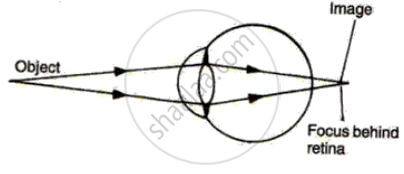Advertisements
Advertisements
प्रश्न
Match the following:
| Column I | Column II |
| (i) Myopia | (a) Converging power of eye lens becomes low |
| (ii) Hypermetropia | (b) Converging power of eye lens remains the same |
| (c) Converging power of eye lens becomes high |
उत्तर
| Column I | Column II |
| (i) Myopia | (c) Converging power of the eye lens becomes high |
| (ii) Hypermetropia | (a) Converging power of the eye lens becomes low |
APPEARS IN
संबंधित प्रश्न
Write the function of the following part of the human eye: crystalline lens
Which. of the following has normal vision?
(a) Xc Xc
(b) Xc Y
(c) XC Xc
(d) Xc Yc
Myopia is an example of ______.
Explain, why a normal eye is not able to see distinctly the objects placed closer than 25 cm, without putting any strain on the eye.
A person got his eyes tested by an optician. The prescription for the spectacle lenses to be made reads :
Left eye : +2.50 D
Right eye : +2.00 D
State whether these spectacle lenses will converge light rays or diverge light rays.
Name the part of the eye:
which changes the focal length of eye-lens.
Name the part of the retina which is insensitive to light.
Give the scientific names of the following parts of the eye:
a clear window at the front of the eye.
Fill in the following blank with suitable word:
The part of eye which alters the size of the pupil is............
Fill in the following blank with suitable word:
The iris controls the amount of................entering the eye.
Ciliary muscles of human eye can contract or relax. How does it help in the normal functioning of the eye?
The human eye forms the image of an object at its ______.
The human eye possesses the power of accommodation. This is the power to:
(a) alter the diameter of the pupil as the intensity of light changes
(b) distinguish between lights of different colours
(c) focus on objects at different distances
(d) decide which of the two objects is closer.
The size of the pupil of the eye is adjusted by:
(a) cornea
(b) ciliary muscles
(c) optic nerve
(d) iris
State whether the following statement is true or false:
Rabbit has eyes which look sideways.
Sometimes you remember a vivid picture of a dream you saw. What is the role of your eyes in this experience?
Give scientific reason:
We cannot clearly see an object kept at a distance less than 25 cm from the eye.
The diagram alongside represents a certain defect of vision of the human eye.
(i) Name the defect.
(ii) Describe briefly the condition in the eye responsible for the defect.
(iii) Redraw the figure by adding a suitable lens correcting the defect. Label the parts through which light-rays pass.
(iv) What special advantage do human beings derive in having both eyes facing forward?

Choose the correct answer.
In the chemistry of vision, the photosensitive substance is _________________
Sketch and label V.S. of a human eye.
Name the following:
Yellow spot and ciliary muscles are found in.
Name the following:
The part of the eye responsible for change in the size of the pupil.
What is the nature of the image that forms on the retina?
Give Technical Term:
The fluid which conveys the vibrations of sound in the cochlea and semicircular canals.
Choose the Odd One Out:
Write the name.
The screen with light sensitive cells in human eye.
The image of an object at an infinite distance is obtained in a real and erect form through a convex magnifying glass.
Write the function of the human eye and label parts of the figure given below.

A person cannot see distinctly objects kept beyond 2 m. This defect can be corrected by using a lens of power
At noon the sun appears white as
We cannot distinguish colours in dim light. Explain giving suitable reasons.
Which of the following statements is correct regarding rods and cones in the human eye?
Which one of the following statements is NOT correct?
State the functions of the following:
Ciliary muscles
Name the following:
Kind of retinal cells sensitive to dim light.
Write the main functional activity of the following structure.
Choroid
Name the following:
Two pigments of the sensory cells.
